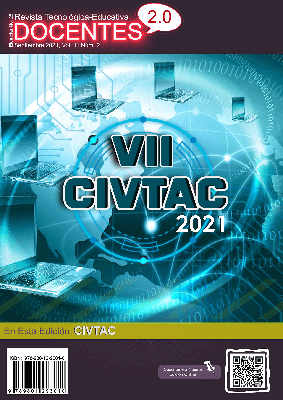Aprendizaje Integrado de Ciencias Sociales e Inglés por Medio de una Unidad Didáctica Basada en la Geografía Local
 DOI:
https://doi.org/10.37843/rted.v11i2.254
DOI:
https://doi.org/10.37843/rted.v11i2.254
Contenido principal del artículo
Resumen
La comunicación e interacción social son la razón de ser del uso de un idioma, por lo tanto, la enseñanza de lenguas debe privilegiar las habilidades relacionadas con la producción oral y la comprensión auditiva. Esta investigación contrasta la dificultad en la enseñanza y aprendizaje del inglés desde un enfoque comunicativo con el aprendizaje integrado de contenidos y lenguas (CLIL). Dicho contraste se dio por medio del diseño de una unidad didáctica de ciencias sociales, con el propósito de analizar la incidencia de CLIL en estudiantes de 12 a 14 años en la Institución José Odel Lizarazo. Para esto, el enfoque se llevó a cabo desde un paradigma cualitativo, proponiendo que la unidad didáctica partiera de la geografía local del departamento de Arauca y con las consideraciones del enfoque basado en tareas. El análisis se realizó por medio de la observación, notas de campo, registro audiovisual, cuestionario de entrada de salida, lo cual permitió comprender que un buen desempeño en la habilidad de “listening” propició la producción oral. Por otra parte, la integración de contenidos de ciencias sociales e inglés favoreció un aprendizaje activo en los estudiantes. Finalmente, el CLIL ofreció una alternativa a la necesidad lingüística de los estudiantes.
Descargas
Métricas
Detalles del artículo

Esta obra está bajo una licencia internacional Creative Commons Atribución-NoComercial-SinDerivadas 4.0.
Aquellos autores que tengan publicaciones en nuestra revista aceptan los términos siguientes:
- En el momento en que una obra es aceptada para su publicación, el autor conserva los derechos de reproducción, distribución de su artículo para su explotación en todos los países del mundo en el formato proporcionado por nuestra revista, así como en cualquier otro soporte magnético, óptico y digital.
- Los autores conservarán sus derechos de autor y garantizarán a la revista el derecho de primera publicación de su obra, el cual estará simultáneamente sujeto a la Licencia de reconocimiento de Creative Commons (Attribution-NonCommercial-NoDerivatives 4.0 International (CC BY-NC-ND 4.0)) que permite a terceros copiar y redistribuir el material en cualquier medio o formato, Bajo las condiciones siguientes: Reconocimiento — Debe reconocer adecuadamente la autoría, proporcionar un enlace a la licencia e indicar si se han realizado cambios. Puede hacerlo de cualquier manera razonable, pero no de una manera que sugiera que tiene el apoyo del licenciador o lo recibe por el uso que hace. NoComercial — No puede utilizar el material para una finalidad comercial. SinObraDerivada — Si remezcla, transforma o crea a partir del material, no puede difundir el material modificado. No hay restricciones adicionales — No puede aplicar términos legales o medidas tecnológicas que legalmente restrinjan realizar aquello que la licencia permite.
- Los autores podrán adoptar otros acuerdos de licencia no exclusiva de distribución de la versión de la obra publicada (p. ej.: depositarla en un archivo telemático institucional o publicarla en un volumen monográfico) siempre que se indique la publicación inicial en esta revista.
- Se permite y recomienda a los autores difundir su obra a través de Internet (p. ej.: en archivos telemáticos institucionales, repositorios, bibliotecas, o en su página web), lo cual puede producir intercambios interesantes y aumentar las citas de la obra publicada.
- El retiro de un artículo se solicitará por escrito al Editor, haciéndose efectivo luego de respuesta escrita de este. Para tal efecto, el o los autores enviarán correspondencia vía E-mail: [email protected].
- El autor no recibirá compensación económica por la publicación de su trabajo.
- Todas las publicaciones de la Revista Docentes 2.0, están bajo la plataforma Open Journal System (OJS) en dirección: https://ojs.docentes20.com/
Citas
Álvarez, A. y Alvarez, V. (2014) Métodos de la investigación educativa. Universidad pedagógica Nacional.
Ball, P., Clegg J. & Kelly, K. (2015). Putting CLIL into Practice. Oxford University Press.
Bisquerra, R. (2004) Metodología de la investigación educativa. Editorial la muralla.
Chenlu, L. (2015). Application of Communicative Method in EFL Listening and Speaking Class. Studies in Literature and Language, 10 (5), 1-4.
Contreras, O. (2012). Stephen Krashen: sus aportes a la educación bilingüe. Rastros Rostros, 14 (27). https://revistas.ucc.edu.co/index.php/ra/article/view/491
Corbin J. & Strauss A. (2002) Bases de la investigación cualitativa. Técnicas y procedimientos para desarrollar la teoría fundamentada. Universidad de Antioquia
Hernández-Sampieri, R. Fernández-Collado, C. & Baptista-Lucio, P. (2014). Metodología de la investigación. McGraw-Hill.
Ministerio de Educación Nacional de la República Colombiana. (2004). Formar para la ciudadanía… ¡Sí es posible! Ascofade. http://www.mineducacion.gov.co/1621/articles-75768_archivo_pdf.pdf
Ministerio de Educación Nacional República de Colombia. (2006). Formar en Lenguas extranjeras: El Reto, lo que necesitamos saber y saber hacer. Espantapájaros Taller.
Howatt, APR. (1984). A History of English Language Teaching. Oxford University Press.
Marín, J. (2018) Investigar en educación y pedagogía, sus fundamentos epistemológicos.
Marsh, D. (2002). Clil/Emile: The European Dimension, Action, Trends and Foreignt Potential. http://europa.eu.int/comm/education/languages/index.html
Ministerio de educación (2019). Encuentro regional saber, ICFES.
Nunan, D. (2004). Task-Based Language Teaching. Cambridge Language Teaching Library. DOI: https://doi.org/10.1017/CBO9780511667336
PEI (2012). Proyecto Educativo Institucional. Institución Educativa José Odel Lizarazo.
Tamayo-Tamayo, M. (2004). El proceso de la investigación científica-Limusa. Noriega Editores.






